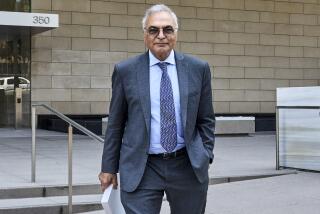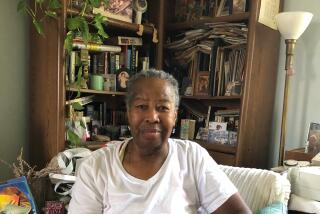Shiley Physician Tells of Heart Valve Warning : Courts: Jurors hear chief clinical investigator recount how he urged redesign to make the potentially fatal device ‘idiot safe.’
SANTA ANA — The Swedish physician whose name is connected to the controversial Bjork-Shiley heart valve said he urged the valve’s manufacturer to make the potentially fatal device “idiot safe” after three people died more than a decade ago.
In a taped deposition played Tuesday during an Orange County Superior Court trial, Dr. Viking O. Bjork, the chief clinical investigator for the Bjork-Shiley Convexo-Concave Heart Valve, said that after welds in small struts used to hold the valves together began snapping, he told engineers at Irvine-based Shiley Inc. to redesign the device, which is about the size of a quarter.
Bjork said he thought the first break, which occurred in 1978, was an accident. But as more valves began to malfunction, he became worried, he said. After a visit to Shiley headquarters, Bjork testified, he informed engineer Paul Morris that he was not concerned about the integrity of the welding as much as human error by those who performed the task.
When plaintiff’s attorney Kenneth S. Kasdan asked if Bjork had suspected that the fractured struts were the result of the welding, the Swedish cardiologist replied:
“I had, but the engineers and I know that the weld is as strong as the material itself. But in comes a human factor in welding, and I have been there to look at it. And I want to avoid the human factor, making it an idiot-safe thing.”
The statements by Bjork, now retired, came during the seventh day of a trial in which Ruth Barillas, 54, of San Diego is suing Shiley Inc. and its New York parent, Pfizer Inc.
Barillas, who had a Shiley valve implanted in February, 1980, is alleging that she has been emotionally distraught and fears for her life since learning in 1991 of potential problems with the device. The valves, which the U.S. Food and Drug Administration approved for sale in 1979, were discontinued in 1986.
Barillas’ husband, Constantino, is also suing the companies for loss of sexual relations.
The taped testimony by Bjork is expected to continue today, with company attorneys’ cross-examination. They are expected to focus on Bjork’s statements that there are risks inherent in all medical devices and that the company had developed a newer, safer model several years after problems were discovered with the older model, Shiley spokesman Robert J. Fauteux said Tuesday.
In fact, Bjork testified that he stopped using the older model in the early 1980s and began to use models that have no welds--so-called mono-strut designs. The new models, which have experienced no breaks so far, are not sold in the United States, Fauteux said.
“An awful lot of material we heard today will receive attention, with some obviously different emphasis,” Fauteux said.
Before the company stopped selling the controversial valve, 86,000 people around the world were fitted with them. Of those, 250 recipients are known to have died because of strut fractures, but some critics estimate that the number is far higher.
Barillas’ attorneys are alleging that Shiley lied to doctors and the FDA, downplaying the potential danger of the device in both so-called “Dear Doctor” letters and company advertisements displayed in medical journals.
During the deposition, Kasdan quizzed Bjork about ads that claimed, among other things, that the Shiley valve reduced blood clotting problems by 50%. Bjork said that the claim is largely wrong, even though the statistic is attributed to him in the Shiley ad.
Such a point is crucial in the plaintiff’s attempt to prove that the company is guilty of fraud.
In another development Tuesday, Henry Piehler, metallurgy professor at Carnegie-Mellon University in Pittsburgh, testified that engineering changes in the valve that were made in 1979 may have exacerbated the problem.
Under questioning by Edward H. Kellogg Jr., another attorney for Barillas, Piehler said that the earlier manufacturing process, in which assemblers actually bent the occasionally defective strut to install the valve flap and bent it back again, potentially weakened the newly welded piece. The flap rocks back and forth against the strut to allow blood flow from the heart.
Piehler said that engineers in 1979 began welding the tiny strut at a deeper angle to the valve, thus allowing its insertion without having to bend the thin wire twice during assembly.
But Piehler said that the new angle made the weld inherently weaker. Barilla’s valve was constructed using the deeper angle.
“I believe it did not serve to prevent strut fracture,” Piehler said. “I believe it may even have served to increase strut fracture.”
But on cross-examination, defense attorney Jack Urguhart lambasted Piehler, asking him if he had ever conducted a study or seen a study conducted by others that proved the modification made matters worse.
“Isn’t it true that you have not done any independent study to verify (the claim)?” Urguhart asked.
“No, I haven’t,” Piehler said. “I have no quantitative data.”
In an effort to discredit Piehler’s testimony, Urguhart also pointed out that the university professor has written about two dozen articles with law professors on product liability law and litigation.
Piehler shot back that he has not written such an article in years, adding a remark that brought laughter to an otherwise tense courtroom, especially among lawyers: “I used to, but I gave it up because nobody reads law journals.”
The plaintiff’s attorneys said that they expect to wrap up their case by Thursday morning at the latest, ending their string of witnesses with Constantino and Ruth Barillas, who are expected to take the stand this afternoon.
Defense attorneys said they will begin their case by calling Dr. Anthony Moulton, a heart specialist at Brown University in Rhode Island, on Thursday afternoon.
The case could go to the jury by the first week in September, Shiley spokesman Fauteux said. If the jury finds the company guilty of fraud, the trial will continue, with both sides presenting evidence for the jury to consider in its computation of punitive damages.
The case will adjourn immediately if the jury finds for the defense, attorneys said.
More to Read
Inside the business of entertainment
The Wide Shot brings you news, analysis and insights on everything from streaming wars to production — and what it all means for the future.
You may occasionally receive promotional content from the Los Angeles Times.









